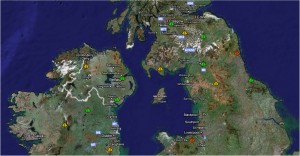Anton Mannering writes about an iPhone Dev Camp happening in Belfast and Dublin.
“The intrepid guys up in the North have been kicking around the idea of an iPhone DevCamp for hose interested in learning how to develop for the platform. … Matt Johnston of the Digital Circle brought this to my attention and is one of the main motivators in making it happen.”
We’re going to get some of the people kicking off some meetups in the two regions – aim of which is to raise awareness of the event and also give us some idea of the coverage. This sort of thing is gaining momentum behind the scenes and therefore we want it to go ahead without a hitch.
At the moment it looks a bit like this:
| POSSIBLE AGENDA | ||
|---|---|---|
| 9:00am | Welcome, and overview | |
| 9:15am | Keynote speaker | |
| 10:00am | Programming Talk 1 – Developing for Cocoa. Someone builds an application live on stage. On the Projector, we can see what he’s doing. Obviously limited to some simpler projects. | Basic Game Development for iPhone – someone goes through the basics of setting up a background, showing accelerometer code, collision code. Keywords: Unity? 3D? 2D? Must bug the UNITY team about this. Spoke to Chris McClelland about the QUB interests in Unity. |
| 11:00am | Coffee and bio break | |
| 11:30am | Programming Talk 2 – Developing for iPhone. Someone builds an application live on stage. | TILT – More on the controls needed for games. |
| 12:30pm | The App Store – Some devs with experience of the Apple App Store talk through their experiences | The Business of Entertainment – Games and entertainment are selling hot on the Apple Store – from the complex Super MOnkey Ball to the simple ‘sound grenade’. |
| 1:00 pm | Lunch | |
| 2:00 pm | Show and Tell Any developers attending take ten minutes to walk through their projects. If they wish, they can open the floor to answer questions and take suggestions. |
Making it special – adding in location based services or even just a high score page on the net for your game. |
| 2:45pm | Coffee and bio break | |
| 3:00pm | Getting your App to the iPhone for development and distribution | |
| 4:00pm | Prize Draw (e.g. books, Pragmatic Programmer gift vouchers, iTunes gift cards) for stuff happening that day – prizes from sponsors. And I think this would be a good opportunity to launch an All Ireland iPhone Competition to run over the next few months. | |
| 4:30pm | Random chattering until home time. | |
It’s not set in stone of course and I kinda want there to be three tracks:
- Developing apps using Cocoa (using the standard Cocoa controls)
- Game development (or developing stuff using OpenGL, collisions, non-standard controls)
- The Business of Apps (or realising that getting your app on the App Store is 10% of the work)
Before then, let’s get together and have Belfast and Dublin Meetups to pave the way – a quick show’n’tell, a quick demo. What do you say?


